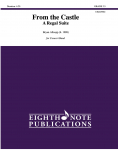Komponist:
Traditional Arrangeur:
Creux, Fulvio Besetzung:
Blasorchester
Genre:
Feierliche Musik • Marsch • Volksmusik Produktart:
Partitur • Stimmensatz “Addio, mia bella, addio” (Farewell, my darling, farewell) is the more popular name for one of the most famous songs of the Italian Renaissance period: “L’Addio del Volontario” (The Volunteer’s Farewell). The words are based on a poem written in 1848 by the Florentine poet, Carlo Alberto Bosi, called “Il Volontario che parte per la Guerra dell’Indipendenza (The Volunteer who left to fight in the War of Independence). Th title was shortened to the more popular “L’Addio del Volontario”, and the first line was also changed, from “Io vengo a dirti addio” (I have come to say goodbye) to “Addio, mia bella, addio”. Like most songs of the period, we do not know the name of the composer, whose theme is repeated in each stanza. This arrangement, composed in June 2000, has no artistic pretensions. It is simply a composition that – far from attempting to offer a collection of ballads – may be of use to bands in particular circumstances. The theme from the famous Renaissance melody is used to create a short song, a brief and evocative picture: a drum sounds in the distance, reproducing the sound of marching soldiers; in a nostalgic atmosphere, two euphoniums play the theme from the folk song and are then joined by the clarinets in chorus; a trumpet blast (reminiscent of Garibaldi’s Anthem) calls the young men to unite and act heroically; after moment’s hesitation (cadence by the clarinet) their minds are made up and they all join “all’armata (che) se ne va” (the army as it marches off) (note how the theme and trumpet blast overlap (bar 44 onwards); the volunteer goes off and his song is lost in the distance, while the echoes of Mameli’s Anthem remind us of the values of the homeland that must be defended.
Folgende Optionen können gewählt werden um diese Ausgabe zu konfigurieren:



